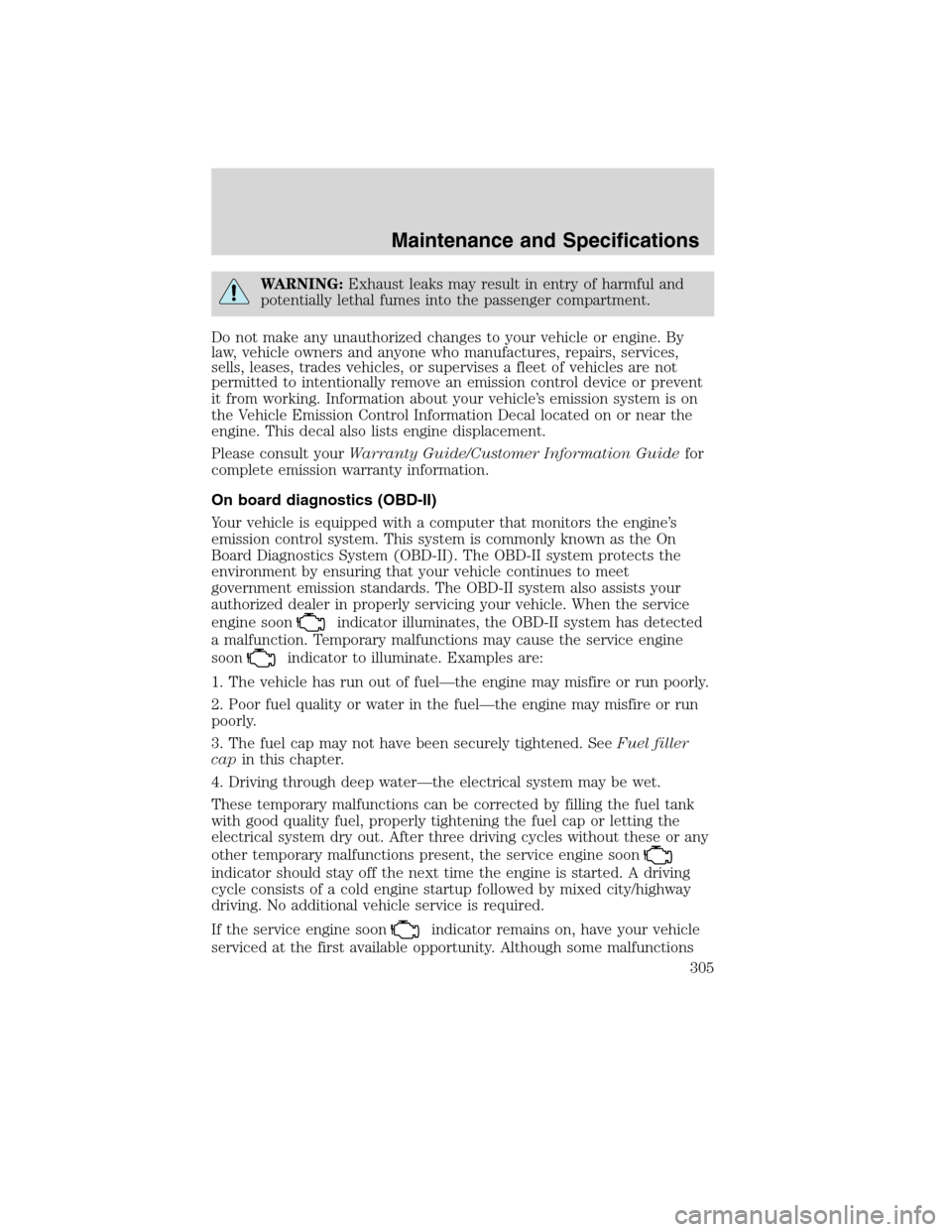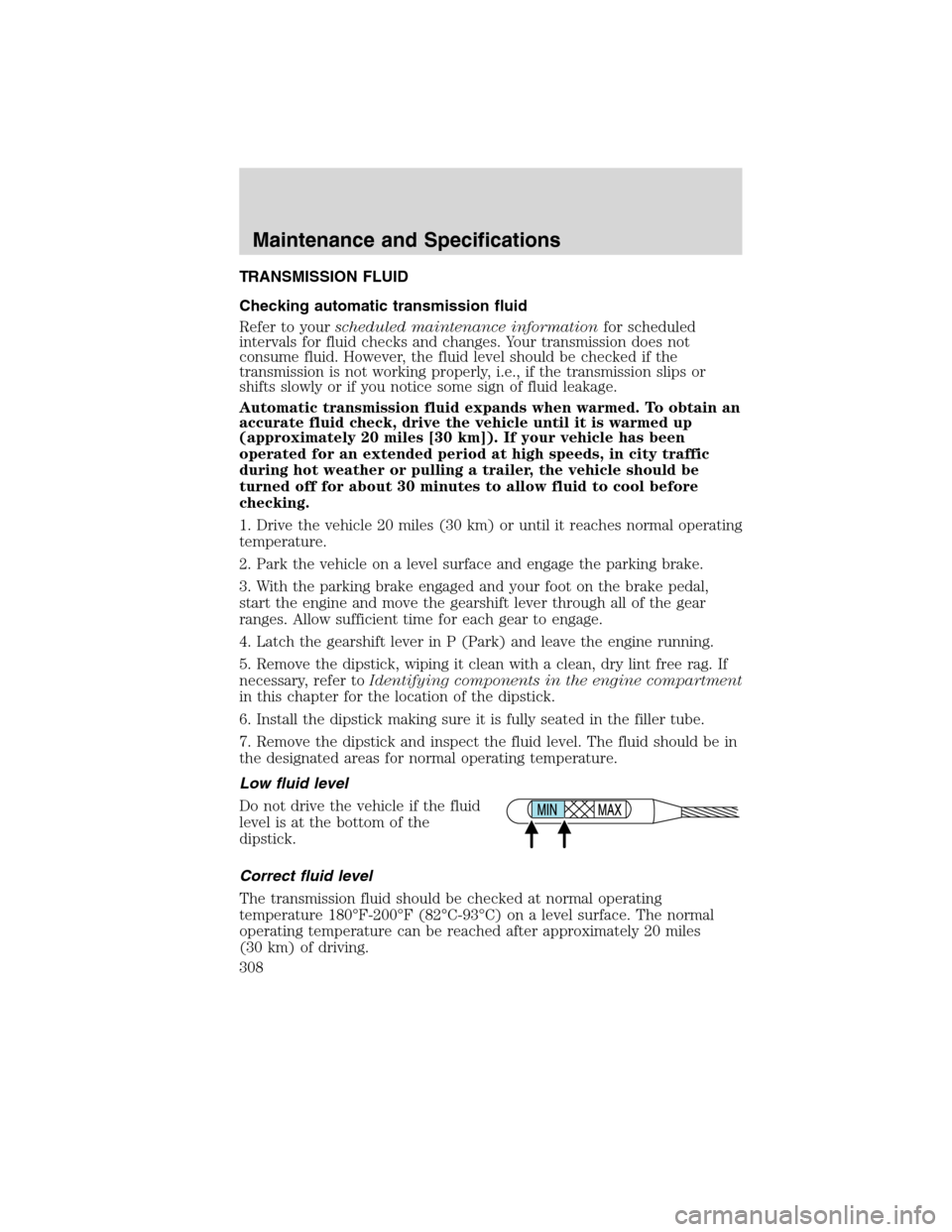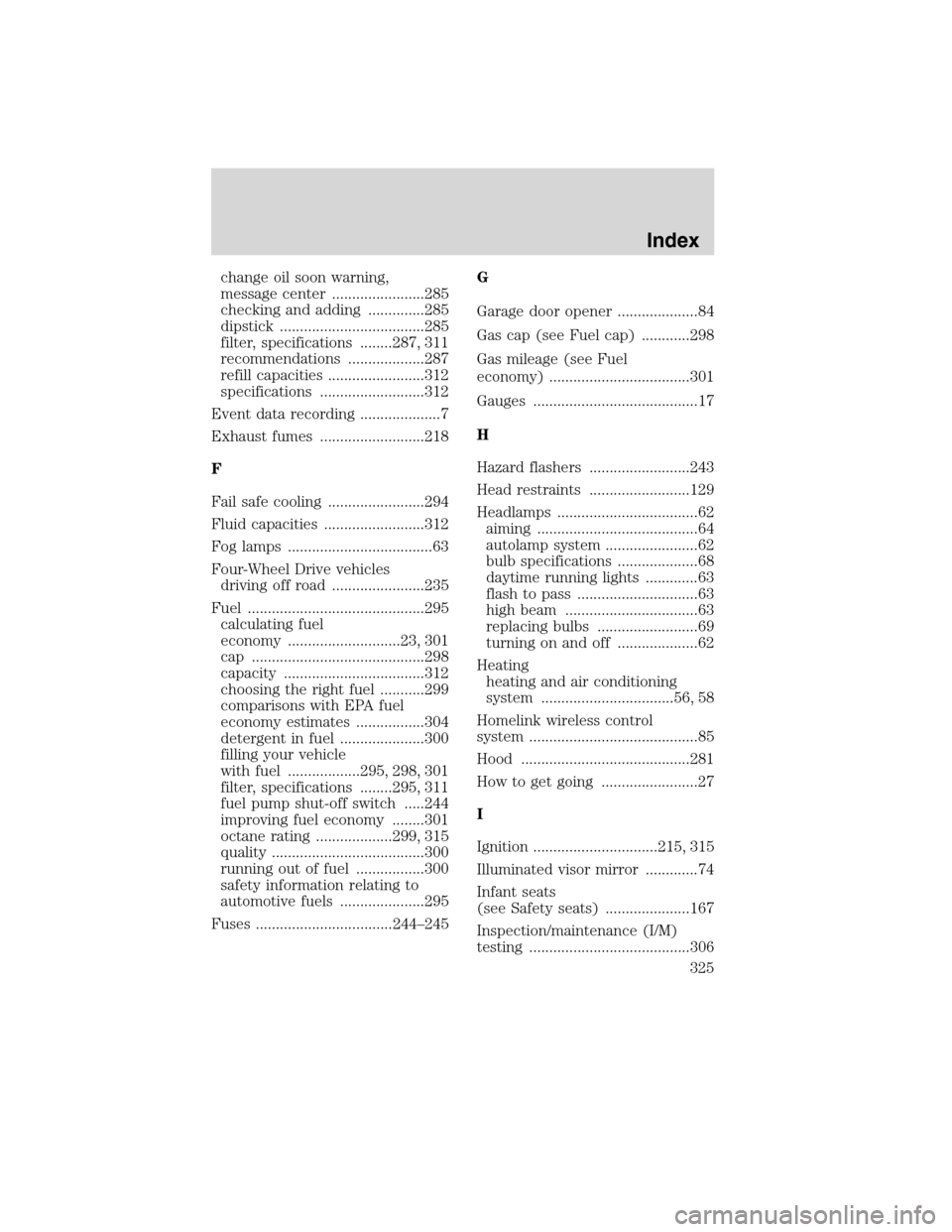change time FORD EDGE 2010 1.G User Guide
[x] Cancel search | Manufacturer: FORD, Model Year: 2010, Model line: EDGE, Model: FORD EDGE 2010 1.GPages: 328, PDF Size: 2.29 MB
Page 305 of 328

WARNING:Exhaust leaks may result in entry of harmful and
potentially lethal fumes into the passenger compartment.
Do not make any unauthorized changes to your vehicle or engine. By
law, vehicle owners and anyone who manufactures, repairs, services,
sells, leases, trades vehicles, or supervises a fleet of vehicles are not
permitted to intentionally remove an emission control device or prevent
it from working. Information about your vehicle’s emission system is on
the Vehicle Emission Control Information Decal located on or near the
engine. This decal also lists engine displacement.
Please consult yourWarranty Guide/Customer Information Guidefor
complete emission warranty information.
On board diagnostics (OBD-II)
Your vehicle is equipped with a computer that monitors the engine’s
emission control system. This system is commonly known as the On
Board Diagnostics System (OBD-II). The OBD-II system protects the
environment by ensuring that your vehicle continues to meet
government emission standards. The OBD-II system also assists your
authorized dealer in properly servicing your vehicle. When the service
engine soon
indicator illuminates, the OBD-II system has detected
a malfunction. Temporary malfunctions may cause the service engine
soon
indicator to illuminate. Examples are:
1. The vehicle has run out of fuel—the engine may misfire or run poorly.
2. Poor fuel quality or water in the fuel—the engine may misfire or run
poorly.
3. The fuel cap may not have been securely tightened. SeeFuel filler
capin this chapter.
4. Driving through deep water—the electrical system may be wet.
These temporary malfunctions can be corrected by filling the fuel tank
with good quality fuel, properly tightening the fuel cap or letting the
electrical system dry out. After three driving cycles without these or any
other temporary malfunctions present, the service engine soon
indicator should stay off the next time the engine is started. A driving
cycle consists of a cold engine startup followed by mixed city/highway
driving. No additional vehicle service is required.
If the service engine soon
indicator remains on, have your vehicle
serviced at the first available opportunity. Although some malfunctions
Maintenance and Specifications
305
2010 Edge(edg)
Owners Guide(own2002), 1st Printing
USA(fus)
Page 308 of 328

TRANSMISSION FLUID
Checking automatic transmission fluid
Refer to yourscheduled maintenance informationfor scheduled
intervals for fluid checks and changes. Your transmission does not
consume fluid. However, the fluid level should be checked if the
transmission is not working properly, i.e., if the transmission slips or
shifts slowly or if you notice some sign of fluid leakage.
Automatic transmission fluid expands when warmed. To obtain an
accurate fluid check, drive the vehicle until it is warmed up
(approximately 20 miles [30 km]). If your vehicle has been
operated for an extended period at high speeds, in city traffic
during hot weather or pulling a trailer, the vehicle should be
turned off for about 30 minutes to allow fluid to cool before
checking.
1. Drive the vehicle 20 miles (30 km) or until it reaches normal operating
temperature.
2. Park the vehicle on a level surface and engage the parking brake.
3. With the parking brake engaged and your foot on the brake pedal,
start the engine and move the gearshift lever through all of the gear
ranges. Allow sufficient time for each gear to engage.
4. Latch the gearshift lever in P (Park) and leave the engine running.
5. Remove the dipstick, wiping it clean with a clean, dry lint free rag. If
necessary, refer toIdentifying components in the engine compartment
in this chapter for the location of the dipstick.
6. Install the dipstick making sure it is fully seated in the filler tube.
7. Remove the dipstick and inspect the fluid level. The fluid should be in
the designated areas for normal operating temperature.
Low fluid level
Do not drive the vehicle if the fluid
level is at the bottom of the
dipstick.
Correct fluid level
The transmission fluid should be checked at normal operating
temperature 180°F-200°F (82°C-93°C) on a level surface. The normal
operating temperature can be reached after approximately 20 miles
(30 km) of driving.
Maintenance and Specifications
308
2010 Edge(edg)
Owners Guide(own2002), 1st Printing
USA(fus)
Page 325 of 328

change oil soon warning,
message center .......................285
checking and adding ..............285
dipstick ....................................285
filter, specifications ........287, 311
recommendations ...................287
refill capacities ........................312
specifications ..........................312
Event data recording ....................7
Exhaust fumes ..........................218
F
Fail safe cooling ........................294
Fluid capacities .........................312
Fog lamps ....................................63
Four-Wheel Drive vehicles
driving off road .......................235
Fuel ............................................295
calculating fuel
economy ............................23, 301
cap ...........................................298
capacity ...................................312
choosing the right fuel ...........299
comparisons with EPA fuel
economy estimates .................304
detergent in fuel .....................300
filling your vehicle
with fuel ..................295, 298, 301
filter, specifications ........295, 311
fuel pump shut-off switch .....244
improving fuel economy ........301
octane rating ...................299, 315
quality ......................................300
running out of fuel .................300
safety information relating to
automotive fuels .....................295
Fuses ..................................244–245G
Garage door opener ....................84
Gas cap (see Fuel cap) ............298
Gas mileage (see Fuel
economy) ...................................301
Gauges .........................................17
H
Hazard flashers .........................243
Head restraints .........................129
Headlamps ...................................62
aiming ........................................64
autolamp system .......................62
bulb specifications ....................68
daytime running lights .............63
flash to pass ..............................63
high beam .................................63
replacing bulbs .........................69
turning on and off ....................62
Heating
heating and air conditioning
system .................................56, 58
Homelink wireless control
system ..........................................85
Hood ..........................................281
How to get going ........................27
I
Ignition ...............................215, 315
Illuminated visor mirror .............74
Infant seats
(see Safety seats) .....................167
Inspection/maintenance (I/M)
testing ........................................306
Index
325
2010 Edge(edg)
Owners Guide(own2002), 1st Printing
USA(fus)